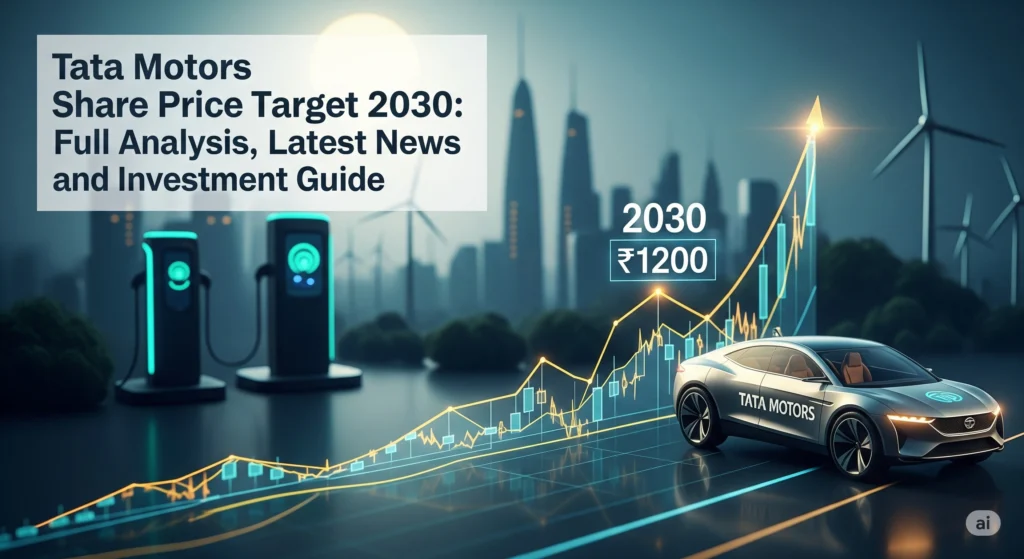AI Summary: Tata Motors Share Price Target 2030
Tata Motors, a leading Indian automaker, is poised for significant growth by 2030, driven by its aggressive electric vehicle (EV) strategy, global expansion via Jaguar Land Rover (JLR), and a robust product portfolio. As of July 30, 2025, the stock trades at ₹668.45 with a market cap of ₹2.46 lakh crores. Analysts forecast a 2030 share price target of ₹2,638–₹3,000, with some estimates reaching ₹4,800, fueled by 30% EV penetration in passenger vehicles, new launches like Sierra EV and Harrier EV, and net-zero goals by 2040–2045. Key risks include competitive EV markets and global economic volatility, while opportunities lie in Tata’s first-mover EV advantage and strong domestic brand. Investors are advised to research, diversify, and monitor long-term trends.
Tata Motors Share Price Target 2030: Full Analysis, Latest News, and Investment Guide
The Indian stock market is abuzz with curiosity around Tata Motors, a company that has not only shaped India’s automotive landscape but is also rapidly evolving into an international powerhouse. As we look ahead to 2030, this comprehensive article brings together the latest price predictions, deep dives into the company’s strategy, data-backed analysis, and actionable guidance for new investors.
Tata Motors: Company Overview and Current Market Snapshot
Tata Motors Limited is one of India’s largest automotive manufacturers, with a diversified product line covering passenger vehicles (PVs), commercial vehicles (CVs), electric vehicles (EVs), and global luxury through Jaguar Land Rover (JLR). As of July 30, 2025, Tata Motors holds a market capitalization of approximately ₹2.46 lakh crores (₹2,46,104 crore) and is trading at ₹668.45 per share on the NSE, following a recent dip triggered by market volatility and acquisition news.
| Parameter | Value |
|---|---|
| Share Price | ₹668.45 |
| Market Capitalization | ₹2,46,104 crore |
| 52-Week High/Low | ₹1,179.00 / ₹535.75 |
| Price-to-Earnings (P/E) | 10.78 – 11.16 |
| Price-to-Book (P/B) | 2.08 – 2.44 |
| Dividend Yield | 0.90% |
| Volume (Avg, 20D) | 7.79 million/day |
Latest News and Company Developments (July 2025)
- July 30, 2025: The stock fell nearly 4% on acquisition speculation involving Iveco, an Italian truck-maker, causing temporary investor nervousness.
- Strategic Capex: Tata Motors will invest ₹33,000–35,000 crore (₹330–350 billion) through FY26–30 for 30 new product actions, including 7 completely new models.
- Net Debt Position: Tata Motors’ Indian operations are now net debt free and aim for Jaguar Land Rover to follow by FY25.
- EV Ambitions: Tata Motors is targeting 30% of PV sales from EVs by 2030 – a dramatic transformation for both the company and India’s automotive sector.
Tata Motors’ Strategic Vision for 2030
Tata Motors’ roadmap for 2030 is built on four pillars:
- Product Expansion: Launch of new vehicles (including the much-anticipated Sierra EV and Harrier EV) and electrifying core models.
- Digital & Software: Advanced investments into software-driven vehicles (SDVs) to stay ahead in the new mobility ecosystem.
- Global & Domestic Growth: Expanding into emerging markets and strengthening global luxury with JLR.
- Sustainability: Ambitious net-zero emissions goals – Passenger Vehicles by 2040 and Commercial Vehicles by 2045, positioning Tata ahead in ESG leadership.
— Economic Times
Tata Motors Share Price Target for 2030: Data-Driven Forecast
Consensus Long-Term Targets
Recent expert analyses and market forecasts provide the following share price targets for Tata Motors by 2030:
| Source | Minimum Target (INR) | Maximum Target (INR) |
|---|---|---|
| Shareprice-target.com (April 2025) | ₹2,638 | ₹3,000 |
| WalletInvestor (July 2025) | ~₹1,423 | — |
| LinkedIn/Analyst Estimate (March 2024) | — | ₹3,831 |
| CoinCodex (USD conversion est.) | $58.23 (~₹4,800) | — |
Analyst Consensus Range: Most Indian equity analysts now forecast a Tata Motors 2030 price target between ₹2,638 and ₹3,000, reflecting sustained growth but accounting for market risks and opportunity costs.
Year-on-Year Target Progression
| Year | Low Target (₹) | High Target (₹) |
|---|---|---|
| 2025 | 720 | 850 |
| 2026 | 900 | 1,200 |
| 2027 | 1,300 | 1,600 |
| 2028 | 1,800 | 2,200 |
| 2029 | 2,300 | 2,700 |
| 2030 | 2,638 | 3,000 |
Factors Driving Tata Motors’ 2030 Share Price Ambition
1. Electric Vehicle (EV) Leadership
- Ambitious EV Penetration: Tata Motors aims for 30% of PV sales from EVs by 2030 — the highest among Indian mass-market automakers.
- Flagship EV Models: Sierra EV, Harrier EV, and Curvv will cater to varied customer segments.
- Charging Infrastructure: Major investments are underway for rapid EV charging network expansion in both metros and Tier-II/III cities.
2. Expanding Product Portfolio
- New Launches: 7 new vehicle nameplates and 23 product refreshes expected by FY30.
- MPV and SUV Focus: The SUV and Multi-Purpose Vehicle categories will remain Tata Motors’ core growth engines, in line with rising Indian demand.
3. Financial Health and Efficient Operations
- Debt Reduction: Core Indian business now net debt free; JLR to follow suit soon.
- Profitability Targets: Company aims for EBITDA margin improvement and 2% additional profit margin on PVs by scaling high-margin EVs and premium vehicles.
4. International & JLR Business Revival
- Turnaround at JLR: Ongoing pivot to electric luxury vehicles, margin expansion, and cost efficiencies headline Tata’s Europe/UK growth play.
Recent Stock Performance: A Look at 2025
| Date | Open | Close | High | Low | Volume |
|---|---|---|---|---|---|
| July 30, 2025 | 690.00 | 668.45 | 690.00 | 665.25 | 18.9M |
| July 28, 2025 | 688.35 | 700.60 | 702.05 | 688.35 | — |
| July 24, 2025 | 693.00 | 706.50 | 706.50 | 692.95 | — |
| July 18, 2025 | 680.25 | 683.20 | 686.00 | 678.00 | 5.56M |
- Volatility in July 2025: The stock price has shown intraday volatility, recently dipping on global acquisition news despite strong long-term fundamentals.
- Average Monthly Performance (Past 17 Years, July): Maximum positive change: 45% (2009), average positive change: 11.37%, maximum negative change: -16.58% (2019).
Tata Motors vs. Peers: Market Position Table (July 2025)
| Company | Mkt Cap (Cr) | 52-Week High | P/E Ratio | EV Strategy |
|---|---|---|---|---|
| Tata Motors | ₹2,46,104 | ₹1,179 | 10.78 | Aggressive (30% PV EV) |
| Maruti Suzuki | ₹4,11,700 | ₹12,003 | ~26 | EV Launch 2025 |
| Mahindra & Mahindra | ₹2,01,238 | ₹2,291 | ~19 | EV, SUV Focus |
| Ashok Leyland | ₹54,900 | ₹201 | ~23 | CV electrification |
Risks and Opportunities for New Investors
Key Risks
- Competitive Pressure: Legacy carmakers and new entrants (global and Indian startups) are vying for the evolving EV market.
- Global Economic Environment: Tata Motors’ JLR business remains sensitive to economic swings in Europe and UK.
- Execution of EV Strategy: Large capital outlay and uncertain EV adoption curve in India and abroad.
Key Opportunities
- First-Mover Advantage in EVs: Early scale in EVs means brand equity and cost efficiencies.
- Strong Domestic Brand: Tata’s innovation and “Make in India” advantage resonate with millennials and Gen Z buyers.
- Portfolio Synergies: Splitting PV and CV businesses into focused entities could unlock further shareholder value.
Step-by-Step Guide for New Investors
- Research and Understand Tata Motors’ Business:
- Study the latest annual reports, analyze product launches, track EV strategy updates.
- Open a Demat & Trading Account:
- Register with a SEBI-regulated stockbroker. Platforms like Zerodha, Upstox, Angel One, ICICI Direct, etc., are beginner friendly.
- Do Your Valuation Homework:
- Check P/E, P/B ratios relative to the sector average for value entry points.
- Read up-to-date analyst research and review quarterly financial results.
- Use Limit Orders:
- Don’t chase a rising stock. Place limit orders to avoid panic buying, especially when volatility is high.
- Diversify:
- Don’t put all your funds in Tata Motors. Include other sectors and asset classes in your portfolio for balanced risk.
- Monitor News and Hold for the Long-Term:
- Track news about Tata Motors, quarterly earnings, and auto industry growth trends.
- Revisit your thesis every 6–12 months.
- Set Realistic Goals:
- Tata Motors is a long-term play on India’s & the world’s EV mobility revolution. Patience and periodic review are key.
Frequently Asked Questions
Analysts expect Tata Motors’ share price to be in the range of ₹2,638—₹3,000 by 2030, with upside potential if the EV business execution and global expansion outperform expectations.
Tata Motors has a strong domestic and global brand, leadership in EVs, a clear investment plan, and a track record of innovation. It is considered a good long-term play by many analysts, but, like all equities, it comes with market risk.
Aggressive EV strategy, robust product launches, JLR turnaround, expansion in international markets, and focus on profitability and sustainability.
Conclusion
Tata Motors is at the forefront of India’s automotive transformation and global EV race. While near-term volatility persists, the long-term outlook towards 2030 is optimistic, supported by data-backed projections and strategic clarity. For new investors, the keys to success are studying the business, investing gradually, and staying updated with the latest news to make informed choices.
Take advantage of Tata Motors’ innovation journey, but always invest with an eye on long-term trends and disciplined risk management.



